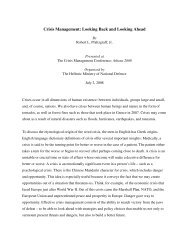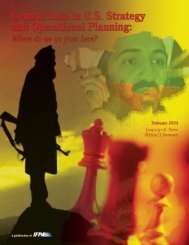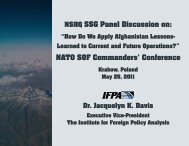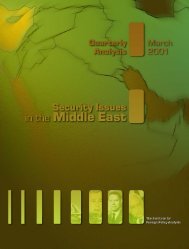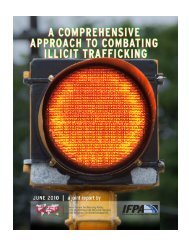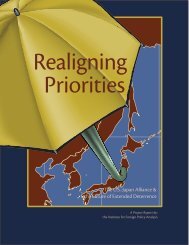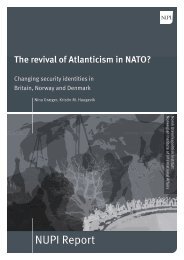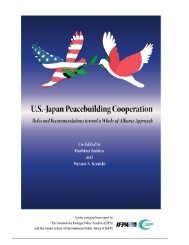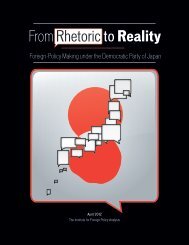US Peacebuilding in Afghanistan - Institute for Foreign Policy Analysis
US Peacebuilding in Afghanistan - Institute for Foreign Policy Analysis
US Peacebuilding in Afghanistan - Institute for Foreign Policy Analysis
Create successful ePaper yourself
Turn your PDF publications into a flip-book with our unique Google optimized e-Paper software.
ISAF leadership has done this on the assumption that local leaders feel that the centralgovernment of <strong>Afghanistan</strong> is fail<strong>in</strong>g to meet their basic needs, specifically <strong>in</strong> the area ofsecurity, and they also assume that permitt<strong>in</strong>g locals to defend themselves would contribute tosolv<strong>in</strong>g a number of issues. These <strong>in</strong>clude, first, that local leaders can meet local needs and thedistrusted central government security <strong>for</strong>ces (specifically the ANP) will not exacerbate thesecurity situation. Second, such groups are required to vouch <strong>for</strong> their loyalty to the governmentof <strong>Afghanistan</strong> <strong>in</strong> order to be recognized as legitimate armed groups. Third, such programsprovide additional troops to fight the Taliban beyond the limited number of Afghan and ISAF<strong>for</strong>ces. Early <strong>in</strong>dications are that ISAF’s plann<strong>in</strong>g assumptions are <strong>in</strong>correct and that locallyarmed groups are unable to drive these effects.Essentially, the U.S. is subvert<strong>in</strong>g the DDR process <strong>in</strong> pursuit of military <strong>in</strong>terests. By do<strong>in</strong>g so,it allows the re<strong>in</strong>troduction (or re-legitimization) of the militia structures that proved so difficultto break <strong>in</strong> the <strong>in</strong>itial years of the war, and it deprives the government of its monopoly onlegitimate violence. These programs have proven disastrous <strong>in</strong> the past as local leaders may besomewhat difficult to accurately identify (a designated militia leader may not lead what ISAFth<strong>in</strong>ks he does), have flexible ideas on loyalty, or may have entered such a program with thespecific <strong>in</strong>tent of defect<strong>in</strong>g later once they have collected all they can from coalition <strong>for</strong>ces.Experience has shown that ISAF’s assumptions need to be reexam<strong>in</strong>ed. The rearmament of localmilitias is revers<strong>in</strong>g the few ga<strong>in</strong>s seen by ANBP and DIAG.ConclusionThis paper has focused on three elements of peacebuild<strong>in</strong>g <strong>in</strong> <strong>Afghanistan</strong> and how the UnitedStates has contributed to them: build<strong>in</strong>g the Afghan National Police, build<strong>in</strong>g the AfghanNational Army, and disarm<strong>in</strong>g, demobiliz<strong>in</strong>g, and re<strong>in</strong>tegrat<strong>in</strong>g armed groups. This focus wasbased on the large scale of these endeavors and their long-term effects on build<strong>in</strong>g a stable peace.There are of course many other peacebuild<strong>in</strong>g activities ongo<strong>in</strong>g <strong>in</strong> <strong>Afghanistan</strong>: economicdevelopment, agricultural support, drug eradication, governmental and constitutional re<strong>for</strong>ms anddevelopment, education support, and medical support, to name but a few. These activities andprograms are supported by the <strong>in</strong>ternational community of donor nations as well as manyagencies from with<strong>in</strong> the U.S. government, such as the Department of Agriculture, theDepartment of Commerce, the Drug En<strong>for</strong>cement Adm<strong>in</strong>istration, the Department of Education,and Health and Human Services. Based on U.S. government policies, however, support<strong>in</strong>gagencies develop their own policies based on DoS and DoD guidance and receive most of theirfund<strong>in</strong>g <strong>for</strong> these activities from DoS and DoD.While peacebuild<strong>in</strong>g <strong>in</strong> <strong>Afghanistan</strong> is an <strong>in</strong>teragency endeavor, the non-DoS and non-DoDelements usually provide only expertise to DoS and DoD operations, ensur<strong>in</strong>g that peacebuild<strong>in</strong>gef<strong>for</strong>ts are controlled by DoS and DoD. Even with<strong>in</strong> this construct, the amount of resources thatDoD br<strong>in</strong>gs to <strong>Afghanistan</strong> is so significantly larger than those available to DoS (which, aga<strong>in</strong>,funds most of the <strong>in</strong>teragency’s programs) that DoD often drives peacebuild<strong>in</strong>g ef<strong>for</strong>ts whether it10




